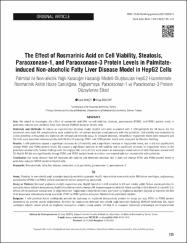| dc.contributor.author | Yakşi, Esra | |
| dc.contributor.author | Özgün, Eray | |
| dc.date.accessioned | 2023-04-28T18:43:53Z | |
| dc.date.available | 2023-04-28T18:43:53Z | |
| dc.date.issued | 2021 | |
| dc.identifier.issn | 2587-0262 | |
| dc.identifier.uri | https://doi.org10.4274/nkmj.galenos.2021.820512 | |
| dc.identifier.uri | https://search.trdizin.gov.tr/yayin/detay/451094 | |
| dc.identifier.uri | https://hdl.handle.net/20.500.11776/11773 | |
| dc.description.abstract | Aim: We aimed to investigate the effect of rosmarinic acid (RA) on cell viability, steatosis, paraoxonase (PON)1, and PON3 protein levels inpalmitate-induced non-alcoholic fatty liver disease (NAFLD) model in HepG2 cells.Materials and Methods: To induce an experimental steatosis model, HepG2 cells were incubated with 1 mM palmitate for 24 hours. For thetreatment, non-toxic RA concentrations were added to the cell culture medium simultaneously with the palmitate. Cell viability was evaluated by3-(4,5-dimethyl-2-thiazolyl)-2,5-diphenyl-2H-tetrazolium bromide assay. To evaluate steatosis, intracellular triglyceride levels were measured andthe cells were examined microscopically with Oil-Red O staining. PON1 and PON3 protein levels were measured by Western blotting.Results: 1 mM palmitate caused a significant decrease in cell viability and a significant increase in triglyceride levels, but it did not significantlychange PON1 and PON3 protein levels. RA caused a significant increase in cell viability and a significant decrease in triglyceride levels in thepalmitate-treated cells. Similar findings with the triglyceride levels of cells were shown in microscopic examination of cells that were stained withOil-Red O. RA did not significantly change PON1 and PON3 protein levels in neither non-treated cells nor treated cells with palmitate.Conclusion: Our study showed that RA increases cell viability and decreases steatosis, but it does not change PON1 and PON3 protein levels inpalmitate-induced NAFLD model in HepG2 cells. | en_US |
| dc.language.iso | eng | en_US |
| dc.identifier.doi | 10.4274/nkmj.galenos.2021.820512 | |
| dc.rights | info:eu-repo/semantics/openAccess | en_US |
| dc.title | The Effect of Rosmarinic Acid on Cell Viability, Steatosis, Paraoxonase-1, and Paraoxonase-3 Protein Levels in Palmitateinduced Non-alcoholic Fatty Liver Disease Model in HepG2 Cells | en_US |
| dc.type | article | en_US |
| dc.relation.ispartof | Namık Kemal Tıp Dergisi | en_US |
| dc.department | Rektörlük, Rektörlüğe Bağlı Birimler, NKÜ Dergileri | en_US |
| dc.identifier.volume | 9 | en_US |
| dc.identifier.issue | 2 | en_US |
| dc.identifier.startpage | 135 | en_US |
| dc.identifier.endpage | 142 | en_US |
| dc.relation.publicationcategory | Makale - Ulusal Hakemli Dergi - Kurum Öğretim Elemanı | en_US |
| dc.identifier.trdizinid | 451094 | en_US |



















